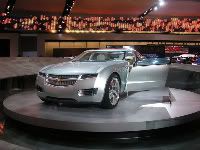Plug-In Hybrids: Now THAT’S Complexity
Here’s a wonderful video that explains the multiple drivetrains at work in the Chevy Volt. A couple of immediate impressions:
1) No wonder the price on this sucker is $41K, with all that going on. The bill of materials (costs of the individual components) must be enough to choke a horse. And the non-recurring engineering costs must have been staggering.
2) This further amplifies my belief that plug-in hybrids really are not the answer to transportation. It’s like using an elephant gun to kill mice. Electric transportation will succeed when we get the price, energy density, and power density of batteries into an acceptable range – and, of course, when we can get enough renewable energy on the grid that we’re not charging them with coal.
So when will this happen? The question is political will. If we rely 100% on market forces, especially while we continue to subsidize fossil fuels, it could be A Long Way to Tipperary.


I’m not convinced that we yet know which vehicle power technologies will will. It is likely that two or more vehicle power technologies will be used simultaneously, depending on circumstances and economics.
It may be that battery technology will never permit long distance driving at a reasonable cost. If so, plug-in hybrids could be a reasonable solution, especially if they used a synthetic fuel, such as NH3. Or, perhaps a battery exchange system will become practical so that when the battery runs low, the driver will pull into a battery exchange station and get a freshly charged battery, the cost depending in part on how much energy is left in the depleted battery. Perhaps some vehicles will run entirely on a synthetic fuel, but with provision to capture the energy that would otherwise be used in braking; it might use ultra capacitors for that.
In any case, we cannot forever use fossil fuels for cars. But the winning technology / technologies will ultimately be determined by economics.
Craig,
As the video shows, EREVs (extended range electric vehicles), are not simply ‘Plug-in hybrids’. The GM Volt is an astonishing example of US engineering, and advanced technology.
All American should feel proud of the GM Volt.
It presents a truly versatile vehicle capable of being driven 40+ miles on electricity alone, and then as a very economical ICE vehicle. It’s versatility enables the Volt/Ampera/Vauxhall to be useful under all circumstances and operate without restrictions.
Is it perfect? Certainly not, but then no technology is perfect!
To encourage the adoption of EREV’s like the GM Volt,the USA, Canada, UK, most of Europe countries, including, France,Germany, Norway, have granted either direct rebates, or Tax Benefits of up to 1/3 the value of the vehicle. In addition these vehicles are exempted from congestion restrictions.
The GM Volt/Ampera is amazing good value and is the next logical step after Hybrid technology. Hopefully, the Volt is only the first of a family of GM Vehicles using Voltec technology, including Cadillac ELR coupes and sedans, and Buick export models.
The additional cost is relatively minimal and as the BACC, RAC,AAA and Better Business, studies establish, the Volt can pay for it’s slightly higher price, within 2.6-5 years of ownership against it’s ICE equivalent.
Since the introduction of the Microwave oven, I can’t remember a product that has met with such disinformation as the GM Volt. The disinformation has been mostly in the US, where it has become a pawn in a political debate.
I’m a little biased, since I confess to being enthusiastic about the Volt from its inception. I have ordered seven (Ampera’s) for our UK branch.